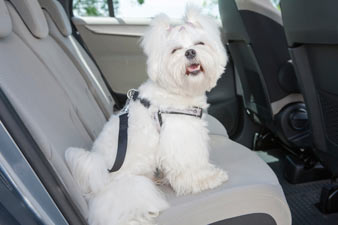Car Sickness in Dogs

Dogs and car rides. They seem to go together like bees and honey. There are times when it can be stressful to take dogs for car rides, though, and chief among these is when your dog has car sickness. It's no fun for you to clean up the car, and it must not be any fun for your dog to feel sick, either. What can be done about car sickness in dogs?
Causes of Car Sickness in Dogs
It helps to understand the common causes of car sickness in dogs before you attempt to help your dog with hers.
-
Puppies often experience motion sickness. Young dogs may experience car sickness that they grow out of. It is thought that this is caused by an immature inner ear structure, the part of the body that helps control balance and vertigo. Some signs of motion sickness in dogs are:
- Becoming very still
- Looking and acting uneasy
- Yawning
- Whining
- Drooling excessively
- Vomiting
- Stress. Stressful situations can cause dogs to vomit. Your dog may become stressed during car rides if she is only taken to places that he associates with negative events such the veterinarian's office, the groomer, or a boarding facility. Car rides can also be linked with stress if your dog is a rescue that associates a car ride with leaving but not returning to her home.
- Reinforcement. Once a dog has experienced nausea or stress in relation to a car ride a few times, it can become a learned behavior. The dog may always have the same reaction in the car because that is the association she has made with it.
Tips for Decreasing Car Sickness in Dogs
Now that you know some of the common causes of car sickness in dogs, it will be easier to formulate a plan for combatting it. Below are some tips for helping your dog with her car sickness:
- Position your dog in the front of the car and keep her facing forward with a dog seatbelt harness. Having your dog face the direction of travel can help her use her eyes to sort out the confusing balance messages that her ears are sending her. The seatbelt does double duty; keeping her in the position that's most helpful to her motion sickness and keeping her safer during an accident. Make sure the seat is back as far as it can go and turn the airbag in front of your dog off if possible.
- Limiting your dog's food and water intake for a SHORT period of time prior to a car ride may decrease her risk of car sickness, but check with your veterinarian first to ensure that this is safe for your dog.
- Lower the car windows a few inches to equalize the outside and inside pressures. This may help your dog's ears to be less overwhelmed by pressure differences. Don't lower the window enough to let your dog hang her head out of the window; she may suffer from an eye injury.
- Keep the temperature in the vehicle cool. Being too hot can add to your dog's anxiety and nausea.
- Try a different vehicle to see if your dog's car sickness is a negative response associated with a particular car. This may help you determine if your dog has motion sickness or anxiety-related car sickness.
- Take your dog on very short car rides (start with around the block) to desensitize her to them. Make sure you give your dog praise for getting into the car.
- Take your dog to enjoyable places like the dog park, pet store, or a trailhead to start a walk so she can begin to develop positive associations with car rides. Taking your dog places that she loves in the car will help her to enjoy riding more and even look forward to it.
- Take your dog to the veterinarian, groomer, and boarding facility for "happy visits" sometimes. During these visits, your dog won't have her usual treatment, but will instead interact positively with the staff, receiving treats and praise. Be sure to call ahead to ensure that you are going at a time that is good for the office staff.
-
If your dog has severe problems with car rides, you may need to work very slowly toward helping her accept them. Use the following steps to help desensitize your dog to her fear of car rides:
- Start by feeding your dog a meal outside of the car, as close to it as she will get without acting nervous. Give her lots of praise for eating calmly.
- Gradually, meal after meal, work your way closer to the car. Eventually, feed your dog in the car with the door open, then close the door partly, then close the door entirely. Do not do this in very hot or cold weather, stay with your dog at all times, and never leave her in the car alone.
- At any step, if your dog shows nervousness, go back to the previous accepted distance. You may have to advance quite slowly if your dog is severely anxious.
-
Once your dog will reliably eat in the car without getting upset, put her in the car, sit with her, and turn the engine on. Give her lots of praise and treats for being calm.
- If your dog gets extremely upset when the engine is turned on, you may have to back up and repeat the above steps with the car running. Make sure that someone is behind the wheel of the car at all times for safety.
- Once your dog sits calmly in the car with the engine on, you can move the car a few feet.
- Be sure that you reward calm behavior immediately. If your dog is peaceful on a car ride around the block and you give her treats and praise when you get home, she will associate the positive rewards with arriving home, not with riding in the car.
- Once your dog can ride short distances calmly, use the tips above in this article: take her places she loves often, and take her to "happy visits" at places that she may have had more negative experiences.
-
Medications can sometimes help dogs with car sickness. Consult your veterinarian to find out if medications may be beneficial in your situation.
- Cerenia is an anti-emetic medication that is labeled for use in dogs with car sickness when the cause is motion related.
- Anti-anxiety medications can be used if your veterinarian feels that nervousness is causing your dog's car sickness.
- Sedatives are sometimes used to allow your dog to rest and decrease his anxiety if a longer car ride is necessary for a dog with anxiety-related car sickness.
Never give medications to your dog without discussing it with your veterinarian first. Many human medications are toxic to dogs or need different doses than humans take.
Using the above tips can have you and your dog enjoying car rides together, free from sickness and stress.
You May Also Like These Articles:
Minding Your P's and Q's At The Dog Park
Disclaimer: This website is not intended to replace professional consultation, diagnosis, or treatment by a licensed veterinarian. If you require any veterinary related advice, contact your veterinarian promptly. Information at DogHealth.com is exclusively of a general reference nature. Do not disregard veterinary advice or delay treatment as a result of accessing information at this site. Just Answer is an external service not affiliated with DogHealth.com.
Notice: Ask-a-Vet is an affiliated service for those who wish to speak with a veterinary professional about their pet's specific condition. Initially, a bot will ask questions to determine the general nature of your concern. Then, you will be transferred to a human. There is a charge for the service if you choose to connect to a veterinarian. Ask-a-Vet is not manned by the staff or owners of DogHealth.com, and the advice given should not delay or replace a visit to your veterinarian.



